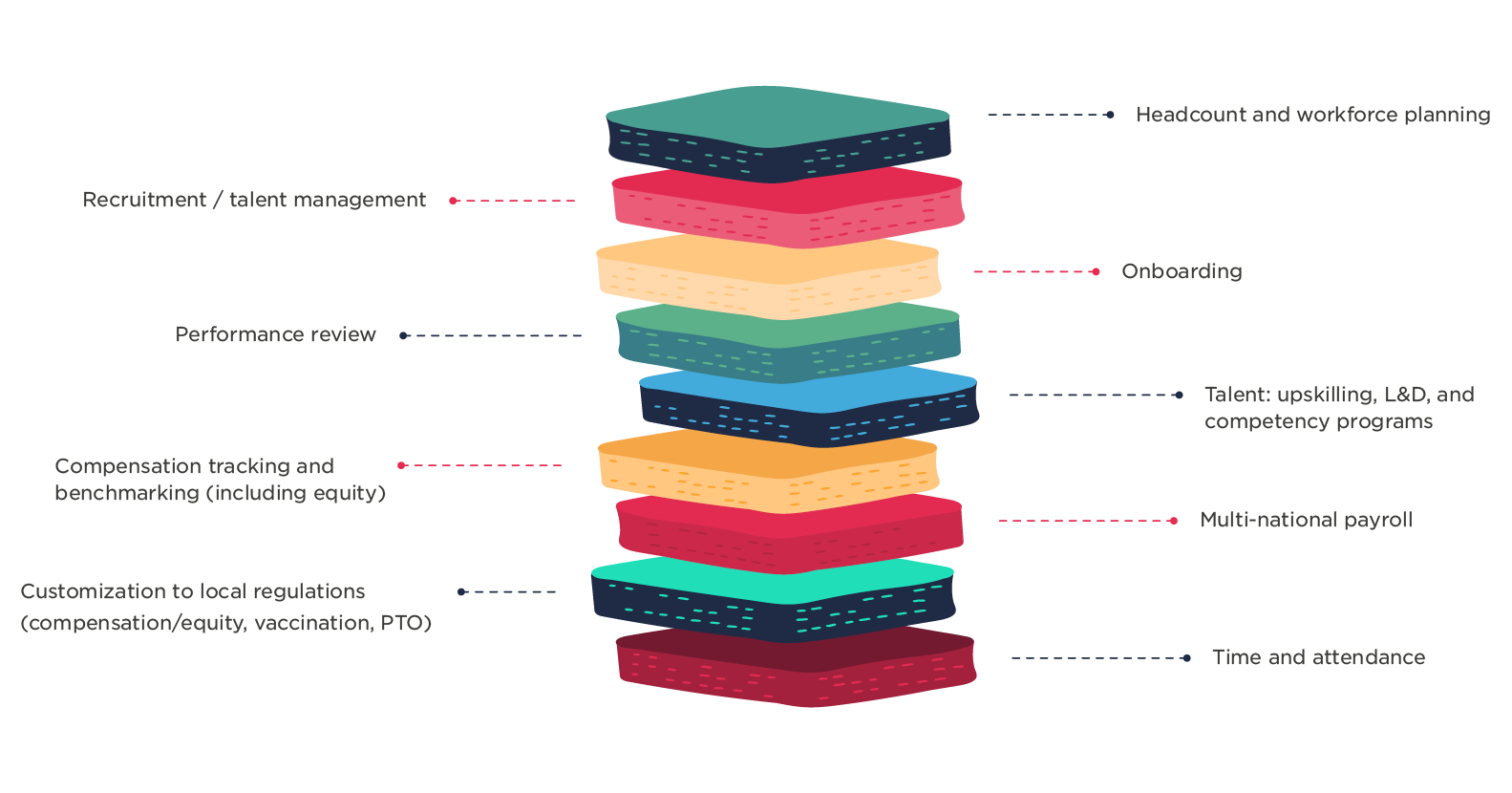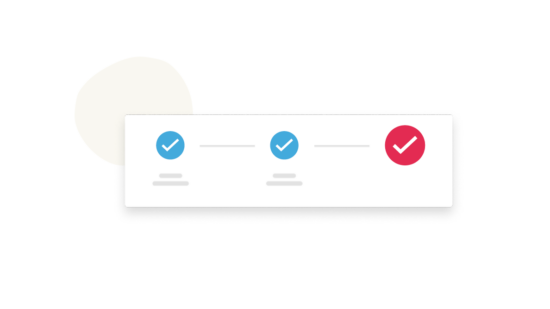Introduction
Companies today are suddenly thinking very differently about compensation. If they want to succeed, they need to adopt a people-centric culture and recruitment strategy that puts competitive compensation packages front and center.
Between the Great Resignation and a tumultuous global economy, a combination of macro and micro factors has made compensation a key strategic issue for companies around the world. One thing is for sure: For all the technological innovations benefiting modern businesses, companies can’t hit their financial and strategic objectives without great people and the talent they bring to the table.
Today’s professionals value flexibility, fulfillment, wellness, and having agency above high salaries. Most importantly, they want to truly share in their organization’s success. If companies don’t provide these progressive benefits alongside competitive pay, people quickly find a company that does–or they remove themselves from the workforce and go into business for themselves.
In response, companies are thinking more creatively about benefits and how to retain and attract the top talent they need. They’re implementing new policies from wellbeing budgets to equity stakes in an effort to incentivize people to stay and join the team.
This isn’t a new idea, just an expanded one: People want to work with organizations that show tangible appreciation to the individuals powering their success. When a company extends equity and financial accountability (ultimately, ownership) to employees, people become more motivated, productive, and engaged–much like executives and investors whose personal successes are intrinsically tied to the company’s.
However, many mid-size companies find themselves in a difficult spot. They may not be able to give hires the dynamism and equity stakes available at early-stage startups. They’re also unlikely to be able to offer the stability and overall compensation level of large enterprises.
So what is the answer for companies looking to stand out? As with so many strategic initiatives, we think the answer is simple: Tie compensation together with culture as well as career growth and development.
At Ledgy and HiBob, we’re fascinated by innovations and new approaches to compensation, HR, and people strategy. In this report, we discuss how the most forward-thinking companies approach compensation today.
Dive in to discover how you can embed compensation into your culture to produce better outcomes for your organization and every individual who has a hand in its success. After all, the mark of truly engaged employees is when your people speak in terms of “our success” as opposed to “the company’s” or “their success.”

Compensation hits the boardroom
People and finance leaders are now presenting a united front at board meetings. Their goal? Secure board buy-in for more imaginative and attractive compensation policies. And largely, modern boards are receptive to the idea that it’s time for old compensation norms to change.
Different leaders share incentives when it comes to reinventing compensation:
- CEOs know that continued sustainable growth depends on hiring the right people
- CFOs know that to hit forecasted targets, hiring plans need to stay on track
- CPOs and HR leaders know that in the current market, being inventive and creative with compensation and benefits is the only way to bring great talent on board and keep it
Getting compensation right could attract great talent, jumpstart growth, and kindle a more welcoming, rewarding culture. But the whole board needs to be aligned on these initiatives. Why?
Because changes to compensation strategy are an outcome of a great culture. If the board can come together around the principles that define how the company treats its most important asset—its people—they can more easily create differentiated compensation plans that make a lasting, positive impact on employee engagement and satisfaction.
To tie compensation to culture, it’s essential to understand what defines your culture in the first place. Mid-size companies might need to ask themselves some provocative questions.
Why would anyone want to work at a mid-size company?
Companies that have progressed beyond their earliest stages but haven’t evolved into large, mature organizations are in a difficult position when it comes to hiring the best talent. They can’t compete with the biggest enterprises to offer the highest salaries and unbelievable perks. They’re also less likely to offer new joiners significant chunks of the business and tempt talent with a shot at life-changing success.
So, how can people and finance leaders in mid-size companies work together to establish compensation as a competitive differentiator? The answer lies in understanding how compensation affects company culture and vice versa.
Mid-size companies have to double down on their own superpowers when the economic case is more uncertain. That means company culture has to come to the fore. People are still close-knit in mid-size companies. Many team members will have been through real ups and downs together, and forged bonds that make their work fulfilling and exciting.
Can you reflect this culture when rewarding and recognizing people for their efforts? Absolutely. Should you? One hundred percent.
Here’s where a full-stack compensation strategy comes in. Full-stack compensation strategies provide a route to building culture through compensation to motivate candidates and create an engaging and values-led team environment.

What makes a full-stack compensation package?
Modern professionals expect to be able to impact the success of their company and see a real-world return. That’s why today’s best compensation strategies are future-thinking and tie employee success to company success.
Compensation has to go well beyond a market-rate salary to be a competitive advantage. But, what does a great modern compensation package look like? Progressive compensation strategies must account for what today’s professionals expect from their employers.
Let’s take a look at six essential components of modern compensation packages and some key questions companies can ask themselves to help take theirs to the next level:
Salary
- Do you have a clear progression framework? How many times a year do you review salaries?
- Which benchmarks and percentiles do you use as references?
Bonuses
- Can you set clear expectations for bonus amounts ahead of performance reviews? Which will be best to execute: annual, quarterly, or monthly bonuses?
Pensions
- Can you use all-hands meetings, documentation, and resources to educate your people about the benefits of pension savings? Can people choose how much they contribute to their pension, and can you match or even exceed their contribution percentage?
Equity
- Are you able to offer options to every employee? Can you create expectations around equity increases with promotions? What about giving away options as the ultimate bonus?
Professional benefits
- If people want or need to relocate, what support can you provide? If people want to choose how and where they work, will you support their choices? Can you offer learning and development opportunities or higher education benefits?
“Lifestyle” benefits
- Can you offer employees and candidates additional holiday days? Could you fund a bike purchase scheme, equal parental leave for mothers and fathers, student loan relief, or childcare subsidies?
Compensation plans can become very complex with so many moving parts, especially for hypergrowth companies expanding internationally. This brings us to the next essential component of any progressive compensation strategy: modern tech tools.
Modern tech tools matter
Traditionally, HR and finance teams have relied on spreadsheets and manual work to track people data. But, the influx of new joiners across different countries holds hypergrowth companies accountable to various local laws and myriad contract types (full-time, part-time, contractor, freelance, etc.). Ultimately, manually collecting, parsing, and tracking data becomes inefficient, if not impossible.
Automating the data collection process is key to building a successful and progressive compensation strategy—and to automate, we need modern tech built to help us do the job. Modern tech tools can cut down the manual work to a few hours (or even minutes), automatically sift through data, quantify benchmarks, and help validate the impact of compensation policies on candidates, team members, and leadership.
Despite executives’ positive intentions, companies are often unable to offer a comprehensive, data-driven approach to compensation. If the appetite is not there to integrate new technologies and improve processes for internal teams and the wider company, outcomes relating to retention and engagement will suffer.
The right compensation tech tools can integrate with top-tier, modern human resources information systems (HRIS). Integrating these tools lets companies automate people-centric processes and build fair, quantifiable compensation into the everyday employee experience, wherever people are based.
What makes up a people tech stack?

Tying compensation to culture
By now, it should be clear that compensation is about so much more than your check at the end of every pay period. So, how can companies ensure that compensation reflects their culture and gets people thinking in terms of “our success” vs. “the company’s success”?
Compensation should make people feel good
Compensation is uniquely helpful in aligning incentives between all stakeholders–the team, the company, and investors. It’s also tied to ownership: giving people a stake in the business’s success gives them a tangible, fiscal reward for their part in building the company and makes them feel valued.
Making people feel valued is critical to any healthy company culture. When it comes to compensation reviews, companies have a real chance to stand out from the crowd. Surprisingly, just six percent of HR leaders conduct pay reviews twice or more per year. Companies that commit to more frequent reviews place themselves at the vanguard of development in the field of compensation, creating a rewarding and exciting employer brand for candidates and current team members.
Compensation affects the whole journey, from hiring to reviews to offboarding
How companies approach compensation makes a huge impact on their people, even before their first day on the job. Companies set positive expectations and standards when they communicate clearly about salary, equity, and benefits throughout the hiring process. This, in turn, helps businesses attract and keep the talent they need to grow and thrive.
Inevitably, people will leave to chase new challenges. How companies treat elements like equity can make a big difference when they do. Some companies insert “bad leaver” clauses that restrict people from retaining shares if they voluntarily leave the company. Instead, companies can boost their employer brand and show their appreciation to anyone who’s ever contributed to their mission by allowing people to retain vested shares after they move on, excluding non-negotiable cases of serious misconduct or contract breaches.
Along the way, software products that integrate and sync with each other can make processes like these easier for internal stakeholders to manage. A simple sync between an equity management platform and an HRIS, for instance, can automatically cancel the vesting process for a person’s shares when they leave the company. This prevents excessive data wrangling on the part of team members, helps prevent errors, and provides HR and finance team members with more time to take on higher-value strategic projects.
Compensation strategy involves every part of the business
Of course, every professional cares about compensation and will have discussions about pay and benefits at intervals throughout the year. But every aspect of the business plays a role in nurturing an effective compensation strategy.
The work of a finance team goes way beyond running payroll at the end of the month, but how many opportunities does your finance department have to present ideas and strategies to the whole business? If your finance and people teams align, they can educate the rest of the company on the positive benefits of stronger employee retention.
People around the company will also better understand compensation’s commercial and cultural importance. As a partner to HR, finance can champion best practices and help build a healthy, people-centric culture.
When every department and function buys into the principles of a full-stack compensation strategy, the work of finance and people teams gets easier, too. Without clear and structured compensation reviews at least twice a year, the HR and people teams must deal with a near-constant flow of questions and challenges from employees and team leads. With less time spent on low-value administrative duties, people are freed up to do what they do best.

Conclusion: Compensation has never been more important to building healthy cultures
Modern companies are constantly searching for ways to deliver more value to their people. At the same time, leadership teams are strategizing on how best to stand out culturally in a competitive talent market. Compensation strategy can be the key differentiator between you and the competition.
Getting compensation right in today’s market can offer companies huge opportunities, including:
- Quicker hiring processes for top-tier talent
- Better retention and motivation from the existing team
- A fair reward system based on effort and results, not geographical or personal biases
In this guide, we’ve articulated some of the foundational principles of great compensation strategies for hypergrowth, mid-size, multi-national organizations. We hope that the information here equips finance and people teams with some of the tools required to kickstart your journey towards building a progressive and competitive compensation strategy befitting the modern workforce.
Recommended For Further Reading
Meet Ledgy
Ledgy is the equity management platform designed for international teams scaling at pace.
Equity is at the heart of any successful company, but managing equity quickly becomes extremely complex as you grow and bring more people on board.
For finance teams, Ledgy provides rich scenario modeling functionality that delivers more insight into the past, present, and future of your share ownership. Granular data analysis lets you take equity out of spreadsheets while making it easy to run complex queries.
For people teams, Ledgy is the most intuitive way to synchronize equity data across your core business systems, integrating with Bob and other leading HRIS platforms to create a single source of truth for vital data.
For legal and operations teams, Ledgy takes the pain out of documentation and information sharing with employees and investors. Easily find any historic transaction in seconds and get documents signed quickly with e-signature integrations.
Today we help more than 2,500+ customers from around the world turn their employees into owners. To learn more about Ledgy’s equity management platform for scaling companies, get in touch via [email protected].
Meet Bob
At HiBob, we’ve built a modern HR platform designed for modern business needs—today and beyond.
An HR platform such as Bob offers a one-stop-shop for all things HR. It sits at the center of your HR ecosystem, is fully customizable, and grows with your organization.
For HR, it delivers automation of many common processes, allows greater oversight and visibility of the business, and centralizes all people data in a secure, user-friendly environment.
For managers, it provides access to data and insights to help them lead more effectively and streamline processes.
For employees, it’s the tools and information they need to connect, develop, and grow throughout their journey.
In a short time, Bob can be deployed to enable communication, collaboration, and connectivity that drives stronger engagement, productivity, and business outcomes.
